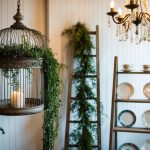Embracing Season Change: Rotating Seasonal Decor
Sustainable Practices in Seasonal Decor
Adopting sustainable practices in seasonal decor allows individuals to enhance their living spaces while minimizing environmental impact. Opting for eco-friendly choices and utilizing reusing and upcycling techniques can make seasonal decor more environmentally conscious.
Eco-Friendly Choices
Choosing eco-friendly materials for seasonal decor reduces waste and supports the environment. Opt for items made from natural and renewable materials like bamboo, wool, or cotton. These materials not only biodegrade more easily but also often require less energy to produce.
Additionally, sourcing decor from local artisans can lower the carbon footprint associated with transportation. Handcrafted items often have a more personal touch and are made with sustainable practices in mind. For those transitioning to fall, consider selecting decor that highlights the tones and textures of the season, such as wooden ornaments or dried leaves, which naturally integrate into any space with minimal harm to the environment.
Reusing and Upcycling
Reusing decor from previous seasons can be both cost-effective and environmentally friendly. Simple adjustments, like swapping out color accents or changing the arrangement, can give a refreshed look without needing new purchases each season. Upcycling old or unused items into new decor also prevents waste. Turning a worn-out sweater into a cushion cover or using glass jars as candle holders are just a few creative examples.
This practice not only reduces landfill waste but also encourages creativity and motivation to see potential in existing items. During the transition to fall, using earthy tones and textures can subtly evolve the home environment, reflecting seasonal changes while adhering to sustainable practices.
Curating Seasonal Accessories
Curating seasonal accessories involves selecting items that reflect the current season and integrating them into a cohesive home design. This process requires attention to detail, an understanding of aesthetic preferences, and a focus on creating visual harmony throughout the living space.
Choosing Seasonal Accessories
Selecting the right accessories is crucial for seasonal decor. It begins with identifying items that naturally align with the season’s characteristics. For instance, spring accessories might include floral patterns, pastel colors, and lightweight materials. Meanwhile, autumn could see richer hues and textures like plaids and heavier fabrics.
Brands play a significant role by offering collections specifically designed for each season. Identifying trusted brands with a reputation for quality and creativity can be motivating. Details such as the material, color, and craftsmanship can influence the overall aesthetic impact. Consumers should also consider the sustainability and ethical production of these accessories to ensure responsible choices.
Integrating a Cohesive Theme
A cohesive theme ties the chosen accessories together, enhancing the visual appeal and comfort of a space. This involves matching colors, patterns, and styles to create a unified look. Homeowners might explore themes such as rustic autumn, which incorporates natural elements like wood and warm colors, or a coastal summer vibe with blues and whites.
The integration of accessories should also reflect personal style, ensuring that the space feels authentic and inviting. Personal preferences can drive the selection of themes, allowing individuals to express unique tastes while maintaining seasonal relevance. It is vital that each piece aligns with the overarching theme to avoid visual clutter and maintain balance.



